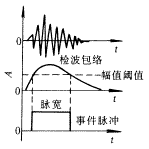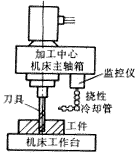In recent years, due to the rapid development of industrial automation, real-time online monitoring of industrial production processes is becoming more and more demanding. At the same time, the requirements for on-line monitoring and real-time monitoring and control of fault quality of major expensive equipment such as FMS and CIMS are more urgent. At present, among the many methods for monitoring the cutting state of the tool, the acoustic emission (AE) method can continuously monitor the whole process of tool damage, which avoids the low frequency region where the vibration and audible noise are seriously polluted during the production process, and is almost free of materials. limits. However, at present, most of the contact type acoustic emission sensors [1, 2] are used at home and abroad, which are not only inconvenient to use, but also susceptible to interference from working conditions; domestic and foreign scholars use advanced techniques and algorithms such as fuzzy pattern recognition and artificial neural networks. , the detection rate is improved, but the real-time performance is reduced, and the system is complicated and the reliability is lowered. The author studies an intelligent acoustic emission sensing monitoring system suitable for automatic tool processing to monitor tool breakage online. It integrates sensors, preamplifiers, signal processing systems and control systems into one body, and is small in size and compact in structure. Installed beside the spindle of the machine tool, it is easy to operate, easy to install, high in sensitivity and strong in anti-interference ability. 1. Principle and structure of the monitoring system Metal or non-metallic materials may exhibit single or multiple bursts of acoustic emission signals at break or crack propagation. These acoustic emission signals have a frequency greater than 100 kHz, which is 4 to 5 times larger than the normally cut AE signal, and has a duration of 0. 2 ~1. 0ms, so the tool breakage signal can be identified as long as the frequency, amplitude and duration of the acoustic emission signal can be identified. Due to the high frequency of the damaged acoustic emission signal of the tool, only the high-speed signal collector can be used to extract the original acoustic emission signal. If the envelope signal is collected and processed, the requirements for the subsequent recognition processing circuit can be reduced. The principle of signal recognition is shown in Figure 1. The magnitude of the AE signal is identified by amplitude identification of the detected signal, and then the length of the AE signal is identified by identifying the pulse width, that is, the double-threshold discrimination method of amplitude and pulse width can be used to identify the acoustic emission signal of the broken tool. . Double threshold judgment is used because it is judged only by the amplitude threshold. There are often some non-tool breakage interference pulse signals causing false alarms. Experiments show that the tool breakage AE signal duration is longer than the interference pulse, so it only exceeds the amplitude threshold and continues. The AE signal with a time of 0. 2ms or more is judged to be a broken tool. Figure 1 Principle of acoustic emission signal recognition The monitor does not use the traditional contact AE sensor, but uses the new AE sensor (integrated in the monitor) of the fluid transmission signal developed by the author. The installation diagram of the monitor is shown in Figure 2. When it is used, it is installed in the original lubrication coolant pipe installation of the machine. When the tool is damaged, the AE signal is transmitted to the monitor by lubricating the coolant in the opposite direction to the flow direction of the lubrication coolant. These liquids are good media for AE signals. The propagation frequency range is large, from a few Hz to several tens of MHz, and since the longitudinal wave can only be transmitted in the liquid, the interference loss during signal propagation is small, the signal distortion is small, and under certain boundary conditions, the variation with the propagation distance can be guaranteed. The attenuation of the signal is small [3, 4]. This provides a guarantee for the use of fluids as a propagation medium for acoustic emission signals. Because of the short transmission path of the installation method, there is no other contact surface in the transmission path, so the sensitivity is high and the anti-interference ability is strong. Since the monitor uses a special adaptive filter that eliminates vibration and noise, the instrument will not cause false alarms even if it is installed near the machine tool spindle where vibration noise is greatly affected. The block diagram of the monitoring system is shown in Figure 3. Figure 2 Monitor installation diagram Figure 3 Acoustic emission monitoring and processing method Next page Here you can find the related products in Conductivity Meter, we are professional manufacturer of Conductivity Meter,Electrical Conductivity Meter,Ph Conductivity Meter,Handheld Conductivity Meter. We focused on international export product development, production and sales. We have improved quality control processes of Conductivity Meter to ensure each export qualified product. Conductivity Meter,Electrical Conductivity Meter,Ph Conductivity Meter,Handheld Conductivity Meter Xi'an Gavin Electronic Technology Co., Ltd , https://www.gaimcmeas.com


If you want to know more about the products in Conductivity Meter, please click the product details to view parameters, models, pictures, prices and other information about Conductivity Meter,Electrical Conductivity Meter,Ph Conductivity Meter,Handheld Conductivity Meter.
Whatever you are a group or individual, we will do our best to provide you with accurate and comprehensive message about Conductivity Meter!